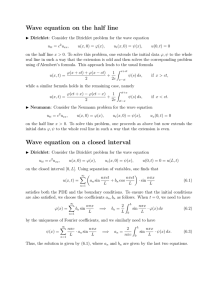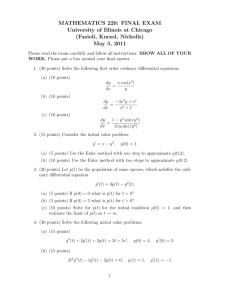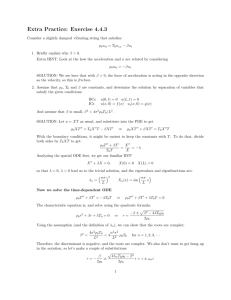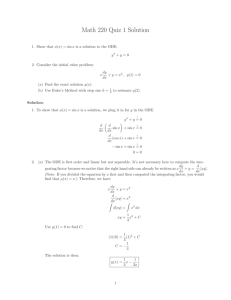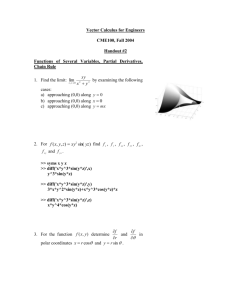Damped wave equation, D'Alembert's solution
advertisement
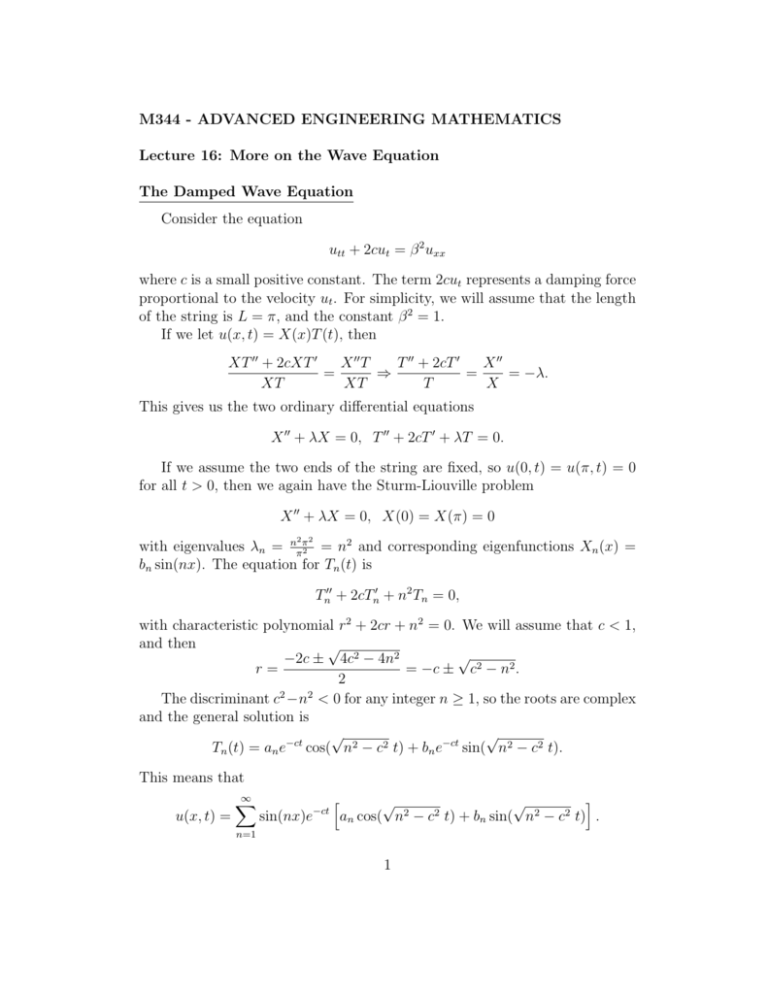
M344 - ADVANCED ENGINEERING MATHEMATICS Lecture 16: More on the Wave Equation The Damped Wave Equation Consider the equation utt + 2cut = β 2 uxx where c is a small positive constant. The term 2cut represents a damping force proportional to the velocity ut . For simplicity, we will assume that the length of the string is L = π, and the constant β 2 = 1. If we let u(x, t) = X(x)T (t), then XT 00 + 2cXT 0 X 00 T T 00 + 2cT 0 X 00 = ⇒ = = −λ. XT XT T X This gives us the two ordinary differential equations X 00 + λX = 0, T 00 + 2cT 0 + λT = 0. If we assume the two ends of the string are fixed, so u(0, t) = u(π, t) = 0 for all t > 0, then we again have the Sturm-Liouville problem X 00 + λX = 0, X(0) = X(π) = 0 2 2 with eigenvalues λn = nππ2 = n2 and corresponding eigenfunctions Xn (x) = bn sin(nx). The equation for Tn (t) is Tn00 + 2cTn0 + n2 Tn = 0, with characteristic polynomial r2 + 2cr + n2 = 0. We will assume that c < 1, and then √ √ −2c ± 4c2 − 4n2 r= = −c ± c2 − n2 . 2 2 2 The discriminant c −n < 0 for any integer n ≥ 1, so the roots are complex and the general solution is √ √ Tn (t) = an e−ct cos( n2 − c2 t) + bn e−ct sin( n2 − c2 t). This means that u(x, t) = ∞ X i h √ √ sin(nx)e−ct an cos( n2 − c2 t) + bn sin( n2 − c2 t) . n=1 1 If the initial conditions are u(x, 0) = f (x), ut (x, 0) = g(x), then u(x, 0) = ∞ X an sin(nx) = f (x) n=1 implies that an = ut (x, t) = ∞ X 2 π Rπ 0 f (x) sin(nx)dx. The partial of u with respect to t is ´i h ³ √ √ −ct 2 2 2 2 sin(nx) −ce an cos( n − c t) + bn sin( n − c t) n=1 h ³ ´i √ √ √ + sin(nx) e−ct n2 − c2 −an sin( n2 − c2 t) + bn cos( n2 − c2 t) ; therefore, ut (x, 0) = ∞ X h i √ sin(nx) −can + n2 − c2 bn ≡ g(x). n=1 This is a Fourier Sine Series for g(x) with coefficients Z √ 2 π 2 2 g(x) sin(nx)dx; −can + n − c bn = π 0 therefore, 1 bn = √ n2 − c2 µ 2 can + π Z ¶ π g(x) sin(nx)dx . 0 The solution of utt + 2cut = uxx , u(0, t) = u(π, t) = 0, for all t > 0 with the given initial conditions is ∞ h i X √ √ u(x, t) = sin(nx)e−ct an cos( n2 − c2 t) + bn sin( n2 − c2 t) , 2 an = π n=1 Z π 0 1 f (x) sin(nx)dx, bn = √ 2 n − c2 µ 2 can + π Z ¶ π g(x) sin(nx)dx 0 Example 1 We will redo the “plucked” string problem from Lecture 15, letting ½ 2 x 0 ≤ x < π2 π f (x) = 2 − π (x − π) π2 ≤ x ≤ π and g(x) ≡ 0. 2 A graph of u(x, t) at t = 0, π8 , π4 , · · · π, and a 3-dimensional plot of u(x, t) for 0 ≤ t ≤ 2π are shown in Figure 1. It can be seen that with c equal to 0.2, the string moves down and back once as t goes from 0 to approximately 2π. However the solution is no longer a sum of exact harmonics; that is, the sines and cosines in successive terms do not have frequencies that are exact integral multiples of a fundamental frequency. In addition, the oscillations in the string damp out to zero as t → ∞. 1 0.8 t =πι/4 0.6 0.8 0.4 0 –0.2 0.4 t =πι/2 0.2 0.5 1 1.5 x 0 2 2.5 –0.4 0 3 –0.4 1 2 3 t 4 5 6 3 1 1.5 x 2 2.5 0 0.5 Figure 1: (a) Position of the string at Figure 1: (b) A 3-dimensional plot of times t = 0, π8 , π4 · · · π the function u(x, t) over 1 period D’Alembert’s Solution of the Wave Equation To solve the wave equation utt = β 2 uxx on the infinite line −∞ < x < ∞, t > 0, it is easier to make the change of independent variables r = x + βt, s = x − βt, and let u(x, t) = w(r, s) = w(r(x, t), s(x, t)). To find uxx and utt in terms of the new variables r and s, we will need the four derivatives ∂s ∂r ∂s ∂r = 1, = 1, = β, = −β. ∂x ∂x ∂t ∂t Then, using the Chain Rule for differentiation of a function of a function ut ≡ ∂u ∂w ∂r ∂w ∂s = + = β(wr − ws ) ∂t ∂r ∂t ∂s ∂t 3 and ∂ ∂r ∂s ∂r ∂s (β(wr − ws )) = β(wrr + wrs − wsr − wss ) ∂t ∂t ∂t ∂t ∂t 2 = β(βwrr − βwrs − βwsr + βwss ) = β (wrr − 2wrs + wss ). utt = Differentiating with respect to x, ux ≡ ∂w ∂r ∂w ∂s ∂u = + = wr + ws ∂x ∂r ∂x ∂s ∂x and uxx = ∂ ∂r ∂s ∂r ∂s (wr + ws ) = wrr + wrs + wsr + wss = wrr + 2wrs + wss . ∂x ∂x ∂x ∂x ∂x If the formulas for utt and uxx are substituted into the wave equation utt = β 2 uxx , β 2 (wrr − 2wrs + wss ) = β 2 (wrr + 2wrs + wss ) and cancelling like terms on each side gives 4β 2 wrs = 0. Since β is a non-zero constant, this implies that wrs (r, s) ≡ 0. This is easily solved by integrating twice, first with respect to s: wr (r, s) = p(r) where p is an arbitrary function of r (since for any such function second integration with respect to r gives: Z w(r, s) = p(r)dr + G(s), ∂p ∂s = 0). A where G is an arbitrary function of s. Now we can write w(r, s) = F (r)+G(s), and therefore u(x, t) = F (x + βt) + G(x − βt) where F and G can be any functions of a single variable. This is the general solution of the wave equation on the infinite line. Now suppose we are given initial conditions u(x, 0) = f (x), ut (x, 0) = g(x). The partial of u with respect to t is ut (x, t) = ∂ (F (x + βt) + G(x − βt)) = F 0 (x + βt) · β + G0 (x − βt) · (−β). ∂t 4 Remember that F and G are functions of one variable. At t = 0 we have u(x, 0) = F (x) + G(x) ≡ f (x) (1) The initial velocity condition gives ut (x, 0) = βF 0 (x) − βG0 (x) = β d (F (x) − G(x)) ≡ g(x). dx Integrating the last equality, 1 F (x) − G(x) = β Z x g(τ )dτ + C. (2) 0 If we add equations (1) and (2) we get µ ¶ Z Z 1 1 x 1 x 2F (x) = f (x) + g(τ )dτ + C ⇒ F (x) = f (x) + g(τ )dτ + C . β 0 2 β 0 Subtracting equations (1) and (2) gives µ ¶ Z Z 1 1 x 1 x g(τ )dτ − C ⇒ G(x) = f (x) − g(τ )dτ − C . 2G(x) = f (x) − β 0 2 β 0 Using these formulas for F (x) and G(x), the function u can be written as u(x, t) = F (x + βt) + G(x − βt) ¶ ¶ µ µ Z Z 1 1 1 x+βt 1 x−βt = g(τ )dτ + C + g(τ )dτ − C , f (x + βt) + f (x − βt) − 2 β 0 2 β 0 and the exact analytic solution of the heat equation is 1 1 u(x, t) = (f (x + βt) + f (x − βt)) + 2 2β Z x+βt g(τ )dτ. x−βt Example 2 To study the behavior of a wave on an infinite line, we will assume the initial position is given by ½ 1 −1 ≤ x ≤ 1 u(x, 0) ≡ f (x) = 0 otherwise and the initial velocity g(x) is identically zero. Let the constant velocity β = 1. 5 1 0.8 1 0.8 0.6 0.4 0.2 0 0 0.5 0.6 0.4 0.2 –4 –2 0 2 x 4 Figure 1: Graph of u at time t = 0.5 –4 1 1.5 t 2 2.5 2 3 –2 0 x 4 Figure 2: 3-dimensional plot of u In Figure (2), the position of the wave at time t = 0.5 is shown on the left, and the 3-dimensional plot shows the wave moving out along the infinite line. (x−t̄) At any time t̄ the function u(x, t̄) is equal to f (x+t̄)+f . This can be graphed 2 by moving the graph of f t̄ units to the right and t̄ units to the left, adding the two functions and dividing by two. When t > 1 the two graphs are completely separated, and the graph of u consists of two copies of f (t)/2 moving to the right and left with speed determined by β. Practice Problems: 1. * Find the solution of utt + 0.4ut = uxx if u(x, 0) ≡ 0 and 0 ≤ x < 0.4π 0 0.2 0.4π ≤ x ≤ 0.6π ut (x, 0) = 0 0.6π < x ≤ π This is the damped version of the piano string, struck at time t = 0. 2. * Solve the equation utt = β 2 uxx on the infinite line, given the initial condition u(x, 0) = sin(x), ut (x, 0) ≡ 0. Describe the behavior of u(x, t) for t > 0. This is a model of a standing wave with no boundaries. How does the value of β affect the wave? 3. * Use MAPLE to make a 3-dimensional plot of the solution of Problem #2, for −20 ≤ x ≤ 20, 0 ≤ t ≤ 6π. Do the plot for β = 1.0 and for β = 0.5. 6
